
Cooking Chicken With Colas
By The Feiloh - Monday, Apr 08, 2013
Way back in 1886, an American pharmacist concocted a tonic for a range of ailments like headaches, upset tummies, and general tiredness. Mixed with carbonated water, the drink shot up in popularity and today, you can find his cola drinks all over the world.
While the market has some dominant cola brand, there are more than a dozen other competitor drinks with similar ingredients. Due to its popularity, and perhaps jealousy from rivals, urban legends have sprung up on alternative uses for this drink, such as a toilet cleaner and polish for silverware.
But now, there is a real alternative use for the cola drink: to flavour cooking. If you do a search on the Internet, you are likely to come across recipes ranging from the savoury to the sweet, using cola drinks in stews, roasts, stir-fries and even cakes.
Besides its distinctive taste, the high sugar content, caramel colour and acidic nip lend the cola drink to culinary applications where such properties are desired, for example, as a tenderiser, marinade or glaze. Do note that only the ‘regular’ cola drink is used for cooking and the diet or ‘light’ varieties are best left as drinks for weight-conscious consumers.
So why, how and when did people start using cola drinks for cooking? To my knowledge, there are no stories on this but we can surmise that it may be due to creativity, accidents, mistakes or even desperation. After all, a flat cola drink does look like light soy sauce or some distracted chef may have knocked over a bottle onto some raw meat.
Like its popularity as a cold drink, the usage of cola drinks in cooking seemed to have gained an international following with a strong following in America, the country of its origin and far away as China and the Philippines.
While there are fairly complex recipes that discourage the neophyte cook from experimenting with it, I have a simple recipe below that is similar to the one for Cantonese oyster sauce chicken, but substitutes the oyster sauce with the cola drink of your choice.
For this recipe, I prefer to use the mid-joint and drumlet of the chicken and leave the wing tips for making stock. However, there are others who think that there is nothing better than slowly sucking the meat off bony chicken wing tips – to each their own; just use what you like.
For me, in cooking, chicken pieces should only be boiled for no more than 15 to 20 minutes (depending on the size of the pieces) to remain tender. Any longer and the chicken will be tough. (Do remember this when you cook your next curry chicken.)
What is nice about this recipe is that there is no need to thicken the sauce with cornstarch as is standard with Cantonese cooking. Just reduce the sauce until a syrupy consistency is achieved. The high sugar content is perfect for that.
So, whenever you have some cola that has gone flat in your fridge, just use it up with the simple recipe below. Here, the cola drink is the star attraction but there are other recipes where the cola drink is only a guest star, lending a hint of its taste to other dominant flavours.
Feel free to experiment with additional ingredients as your creativity leads you.

Ingredients
1) About 10 wings, mid-joint and drumlet preferred
2) 1 can of your preferred cola drink (about 300ml, at room temperature)
3) 1 small onion (cut into small pieces)
4) 1 slice of ginger
5) 1 tbsp of cooking oil
6) 1 tsp of light soy sauce
7) Water (if necessary)
Method
1) Put in the oil, onion pieces and ginger in a small pot or saucepan and sauté over medium-low heat for a few minutes until the aromatic flavours are released.
2) Add the remaining ingredients. If the cola liquid is insufficient, add enough water to just cover chicken pieces.
3) Adjust the heat to a gentle boil and cook for 15 minutes, or until chicken is just cooked.
4) Remove the chicken pieces and continue boiling the liquid for another 5-10 minutes, or until the liquid is reduced to a syrupy gravy.
5) Pour gravy over chicken and serve or use it as a dip.


